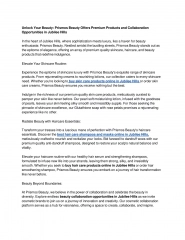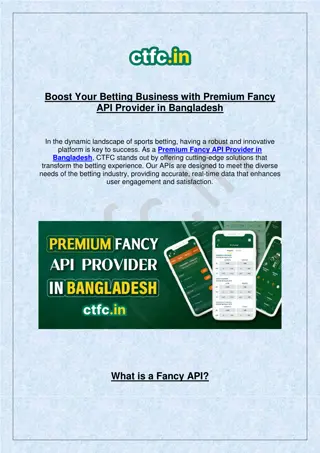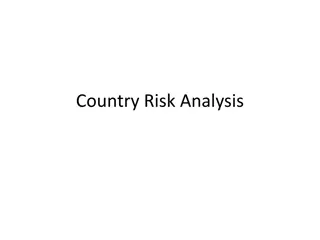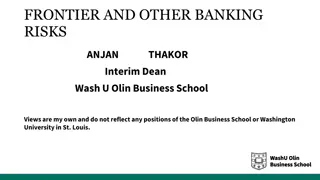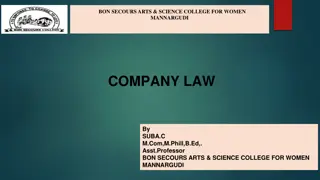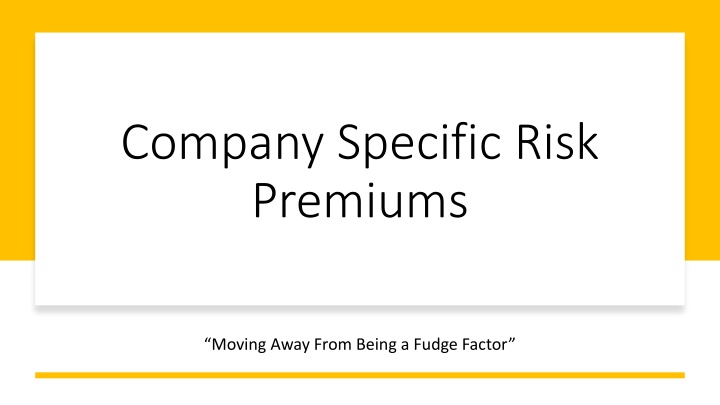
Moving Away from Fudge Factors in Company Specific Risk Premiums
Explore the evolution of company specific risk premiums and their importance in valuations. Gain insights on ideal CSRPs for start-up valuations, considerations for cost of equity, and more in this informative presentation. Please note that the content does not constitute professional advice.
Download Presentation

Please find below an Image/Link to download the presentation.
The content on the website is provided AS IS for your information and personal use only. It may not be sold, licensed, or shared on other websites without obtaining consent from the author. If you encounter any issues during the download, it is possible that the publisher has removed the file from their server.
You are allowed to download the files provided on this website for personal or commercial use, subject to the condition that they are used lawfully. All files are the property of their respective owners.
The content on the website is provided AS IS for your information and personal use only. It may not be sold, licensed, or shared on other websites without obtaining consent from the author.
E N D
Presentation Transcript
Company Specific Risk Premiums Moving Away From Being a Fudge Factor
This presentation and the accompanying talk by the speaker does not, and is not intended to, constitute legal advice/Professional Advice. Instead all information, content and materials available in this presentation and the accompanying talk and materials are for general information purposes only. Users are expected to exercise caution and diligence when using this material. This presentation does not, is not intended to, replace independent professional judgement. The speaker or the organising department will not be liable for any liabilities ,by whatever, arising out of acting/not acting on the basis of information provided in this presentation and the accompanying talk. Disclaimers The views expressed in this presentation and the accompanying talk are of personal views of Anjan Babu.S , the speaker only. It is neither of Bangalore Valuers Associations nor of Anjan and Co Chartered Accountants. Every effort has been made to offer the most current and accurate information to users. But errors can occur. The information provided is as is with no guarantees of completeness, accuracy or timelines. To the fullest extent permissible pursuant to applicable law, the speaker and the associated organisations including the Income Tax department disclaims all warranties, express or implied.
To my Gurus Shri. Abraham Mathews, who has guided and mentored me in valuations. Bangalore Valuers Association and its management committee for the consistency in organizing sessions despite their personal/professional commitments. Shri.Nataraja Nanjundiah for bringing forth the idea to take part in this session. CS.Silpa Kiran in organizing the programme. Ms.Vijaya for co-ordination Learned members of BVA who constantly push the speakers and expect high standards out of them. Credits and Acknowledgements
Time (Min) Sl.No Topic of Discussion Speaker 1 Survey and Discussion Mr. Anjan Babu 10 2 Case Laws on CSRP and the need to re-look at traditional approaches Mr. Anjan Babu 15 Flow of Discussion 3 Unsystematic Risk considerations to scrutinize CSRP assumptions (Qualitative Approach) Mr. Nataraja Nanjundaiah 20 4 Structured Approach to CSRP with an example scenario Mr. Anjan Babu 40 5. Discussions + Q&A Mr. Anjan/ Mr. Nataraja 25
0 5% What should be the ideal CSRP range for start-up valuations? 5% - 15% 15% - 25% >25% Case to case basis. Sometime as low as 0% and sometimes as high as 50% Compute CSRP using some logical model
Cost of Equity Where should the CSRP be added? Cost of Debt WACC
When the subject company experiences more qualitative risks than the comparable guideline public company. Which of the following situations warrant a higher CSRP? Overly optimistic free cash flow projections by management Similar company in industry got a lower valuation. Fixed inputs are not yielding the valuation multiple of similar company. Revenue/Profitability targets of previous projections have not been met. All of the Above None of the Above
Rating of Qualitative factors and assigning ranks and Computation of risk Which of the following approach do you use in your practice to arrive at CSRP? ICAIRVO Insights on Valuation Series guidance (deviation over certain metrics over actuals vs projected year) Range of CSRP based on type of company Total Beta Method/Butler Pinkerton Model Differential factor used to arrive at an acceptable valuation range. (Matches with Industry turnover multiple, EBIDTA Multiple etc) Build-up Method Other Methods (Please Explain)
Can companies practically be assigned 0% CSRP? Yes No
Case Laws and Criticism of Traditional CSRP Factors that should motivate valuators to adopt structured approach
In rejecting its use in Sunbelt, the court found that the reasons supporting the application of a CSRP as presented by the defendants expert were not, in fact, company specific but rather applicable to all industry participants. The court therefore implied that the risks intended to be captured in the CSRP were already captured in the discount rate that was estimated based on industry participants. IN RE SUNBELT IN RE SUNBELT BEVEREAGE CORP: BEVEREAGE CORP: Delaware Court of Delaware Court of Chancery Chancery
The calculation of a company-specific risk is highly subjective and often is justified as a way of taking into account competitive and other factors that endanger the subject company s ability to achieve its projected cash flows. It is often a back-door method of reducing estimated cash flows rather than adjusting them directly. Pure proponents of the CAPM argue that only systemic risk as measured by Beta is relevant to the cost of capital and that company-specific risks should be addressed by appropriate revisions in cash-flow estimates. The company-specific risk premium often seems like the device experts employ to bring their final results into line with their clients objectives, when other valuation inputs fail to do the trick. In Delaware Open MRI Radiology Associates, P.A. v. Howard B. Kessler
In Union of Illanois. 1995 Inv. LP v. Union Financial Group Ltd A company-specific risk premium is not an addition to the CAPM that is accepted by corporate finance scholars, but is sometimes added to the discount rate by practitioners valuing a company to reflect that the company has risk factors that they believe have not already been captured by the equity risk premium as modified by beta and (if applicable) the small company size premium. Pure proponents of the CAPM argue that only systemic risk as measured by beta is relevant to the cost of capital and that company-specific risks should be addressed by appropriate revisions in cash-flow estimates If there are concerns about projection risk because the projections were generated by an inexperienced management team, the company s track record is such that estimating future performance is difficult even for an experienced management team, or projections seems to be infected with a bias, it would be better for the expert to directly express his skepticism by adjusting the available projections directly in some way, to make plain his reasoning. Admittedly, this would involve as much subjectivity as heaping on to the discount rate, but it would also force more rigor and clarity about the expert s concern.
Be careful not to offset worries about a project s future performance by adding a fudge factor to the discount rate. Fudge factors don t work, and they may seriously undervalue long- lived projects. - Brealey, Myers and Allen
Other criticisms There is inconsistent use/justifications for use of CSRP: For adjustments between guideline company and subject company To adjust risk emanating from biased cash flows To account for risks accepted by investors that may not hold diversified portfolios. Inability to translate qualitative risks to actual measurements in expected returns.
Total Beta and Butler-Pinkerton Model More Science and Less Art in computing Company Specific Risk Premiums
Total Beta, introduced by Prof.Damodaran, is a measure used to determine the risk of a stand-alone asset, as opposed to an additional asset added to a well-diversified portfolio. What is Total Beta Method? Application of Total Beta Adjustment is based on the context of valuation. If the valuation is for sale of shares other than in IPO/non-diversified investors, total Beta adjustment may be used. Total Beta adjustment is hence a good tool for private company valuations Butler Pinkerton Model of CSRP computation is derived from Total Beta
Total Beta can be computed using the formula below: How to compute Total Beta ?(???????) ? ????? ???? = where R is Correlation Co-efficient between guideline comparable public company with the Market. The total beta will be higher than the market beta and will depend upon the correlation between the firm and the market, the lower the correlation, the higher the total beta.
Compute Step 1 : Compute Total Beta of Guideline comparable companies What are the steps to valuation when using Total Beta for private entities Step 2 : Identify Small company Risk Premium for guideline comparable company Identify Step 3 : Compute Company Specific Risk Premiums of Comparable Companies using Butler Pinkerton Approach BPC Step 4 : Gather Annual Reports of Comparable companies and note down major areas and reportings under Risk Management Report. You may also refer prospectus when initial offer was made to understand risk areas. Gather Step 5: Interview the client and collect evidences on the matters of Risk for the subject industry. Interview Step 6: Determine range of CSRP by being closer to the company which is most comparable on qualitative grounds. Determine
CSRP under BPC is derived from Total Cost of Equity computed using Total Beta. Butler Pinkerton CSRP Total Cost of Equity (TCOE) = Risk free rate + Total Beta*Equity risk premium. TCOE = Risk-free rate + (Beta*Equity risk premium) + Size premium + CSRP Solving for the only unknown in the equations leads us to: CSRP = (Total Beta Beta)*Equity risk premium Size premium This approach has been accepted by the Delware Court //Model Computation for Indian software companies to be shown in Excel//
Qualitative Comparisons Points to note: Eliminate differences arising out of size as size premium would be captured (Like market value of equity, book value of equity, market value of invested capital, book value of invested capital, sales, net income, EBITDA or number of employees, etc.) Ignore industry wide considerations as it would be captured in systematic risk. ework.pdf Further reading on this example (Page 2/7) https://data.bvresources.com/pdf/Empirical%20Fram
Rank the company specific factors Collect and distribute rankings between Most, Moderate and Less Risk There must be atleast 2 comparable companies. More than 2 comparable companies would yield the best results It would be ideal to determine CSRP mid way between two comparable companies.
Use Sum Beta as opposed to regular levered Beta when computing Total Beta for thinly traded guideline companies. CSRP can never be negative. Even the largest of companies have some CSRP under the Total Beta method. Other FAQs
Has limitations to the extent of CAPM Approach. The technique violates the theory of CAPM by replacing Beta with Total Beta Critics of total beta argue that there is no theoretical basis for total beta as a measure of total risk. Limitations of this approach
Publicly available data of share prices etc are for minority/market holding and may not be for controlling stake. How does it affect the computation? The difference between Pre-IPO Prices and Listing prices can be considered as DLOM. However, it may also include a component of undiversified risk. Total Beta considers undiversified risk but may not consider DLOM. Extent of DLOM may have to be reduced when adopting DLOM Answers to the questions that I do not know
Total Beta Adjustment : Prof.Damodaran https://pages.stern.nyu.edu/~adamodar/New_Home_Page/valquestions/totalbeta.htm Small Company Premium in India by Incwert Further Reading Material/Data Sets: https://secureservercdn.net/160.153.138.42/end.241.myftpupload.com/wp-content/uploads/2021/08/2021-India- Size-Premia-Study-by-Incwert.pdf FAQs on using Butler Pinkerton Calculator of BVR https://www.bvresources.com/products/faqs/butler-pinkerton-calculator#:~:text=risk%20premium%20or- ,TCOE%20%3D%20Risk%2Dfree%20rate%20%2B%20Beta*Equity%20risk,premium%20%2B%20Size%20premium%2 0%2B%20CSRP. Sample Computation: https://data.bvresources.com/pdf/BPMsample.pdf Practical Example with Addendum: https://data.bvresources.com/pdf/Empirical%20Framework.pdf , https://data.bvresources.com/pdf/PracticalExampleAddendum.pdf Company Specific Risk Premium and Total Beta Chapters : Cost of Capital Applications and Examples (5th Edition) SBBI, 2008 Valuation year book for definition and calculation of Sum Beta
Thank you! Anjan Babu.S. (ACA, RV SFA, D.ISA) Ph: +91- 8105568234| anjan@anjanandco.com | https://www.linkedin.com/in/ca-anjan-babu/

